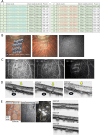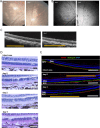Graft cell expansion from hiPSC-RPE strip after transplantation in primate eyes with or without RPE damage
- PMID: 38698112
- PMCID: PMC11065889
- DOI: 10.1038/s41598-024-60895-w
Graft cell expansion from hiPSC-RPE strip after transplantation in primate eyes with or without RPE damage
Abstract
Clinical studies using suspensions or sheets of human pluripotent cell-derived retinal pigment epithelial cells (hiPSC-RPE) have been conducted globally for diseases such as age-related macular degeneration. Despite being minimally invasive, cell suspension transplantation faces challenges in targeted cell delivery and frequent cell leakage. Conversely, although the RPE sheet ensures targeted delivery with correct cell polarity, it requires invasive surgery, and graft preparation is time-consuming. We previously reported hiPSC-RPE strips as a form of quick cell aggregate that allows for reliable cell delivery to the target area with minimal invasiveness. In this study, we used a microsecond pulse laser to create a local RPE ablation model in cynomolgus monkey eyes. The hiPSC-RPE strips were transplanted into the RPE-ablated and intact sites. The hiPSC-RPE strip stably survived in all transplanted monkey eyes. The expansion area of the RPE from the engrafted strip was larger at the RPE injury site than at the intact site with no tumorigenic growth. Histological observation showed a monolayer expansion of the transplanted RPE cells with the expression of MERTK apically and collagen type 4 basally. The hiPSC-RPE strip is considered a beneficial transplantation option for RPE cell therapy.
© 2024. The Author(s).
Conflict of interest statement
The authors declare no competing interests.
Figures





Similar articles
-
Allogenic Transplantation of RPE Strips Lacking MHC Class II Can Avoid Rejection in Nonhuman Primate Eyes.Invest Ophthalmol Vis Sci. 2025 Jun 2;66(6):53. doi: 10.1167/iovs.66.6.53. Invest Ophthalmol Vis Sci. 2025. PMID: 40525923 Free PMC article.
-
Human iPS cell derived RPE strips for secure delivery of graft cells at a target place with minimal surgical invasion.Sci Rep. 2021 Nov 2;11(1):21421. doi: 10.1038/s41598-021-00703-x. Sci Rep. 2021. PMID: 34728664 Free PMC article.
-
Characterization of human induced pluripotent stem cell-derived retinal pigment epithelium cell sheets aiming for clinical application.Stem Cell Reports. 2014 Jan 23;2(2):205-18. doi: 10.1016/j.stemcr.2013.12.007. eCollection 2014 Feb 11. Stem Cell Reports. 2014. PMID: 24527394 Free PMC article.
-
[Preclinical Study of Human Induced Pluripotent Stem Cell-derived Retinal Pigment Epithelium Cell Sheets Transplantation].Nippon Ganka Gakkai Zasshi. 2016 Nov;120(11):754-63. Nippon Ganka Gakkai Zasshi. 2016. PMID: 30074740 Review. Japanese.
-
Induced pluripotent stem cell-based therapy for age-related macular degeneration.Expert Opin Biol Ther. 2017 Sep;17(9):1113-1126. doi: 10.1080/14712598.2017.1346079. Epub 2017 Jun 30. Expert Opin Biol Ther. 2017. PMID: 28664762 Review.
Cited by
-
Allogenic Transplantation of RPE Strips Lacking MHC Class II Can Avoid Rejection in Nonhuman Primate Eyes.Invest Ophthalmol Vis Sci. 2025 Jun 2;66(6):53. doi: 10.1167/iovs.66.6.53. Invest Ophthalmol Vis Sci. 2025. PMID: 40525923 Free PMC article.
-
Animal models for the evaluation of retinal stem cell therapies.Prog Retin Eye Res. 2025 May;106:101356. doi: 10.1016/j.preteyeres.2025.101356. Epub 2025 Apr 14. Prog Retin Eye Res. 2025. PMID: 40239758 Free PMC article. Review.
-
Transplant of Induced Pluripotent Stem Cell-Derived Retinal Pigment Epithelium Strips for Macular Degeneration and Retinitis Pigmentosa.Ophthalmol Sci. 2025 Mar 18;5(4):100770. doi: 10.1016/j.xops.2025.100770. eCollection 2025 Jul-Aug. Ophthalmol Sci. 2025. PMID: 40296985 Free PMC article.
-
Retinal Pigment Epithelium Transplantation in Retinal Disease: Clinical Trial Development, Challenges, and Future Directions.Biomolecules. 2025 Aug 15;15(8):1167. doi: 10.3390/biom15081167. Biomolecules. 2025. PMID: 40867611 Free PMC article. Review.
References
Publication types
MeSH terms
Grants and funding
LinkOut - more resources
Full Text Sources
Miscellaneous

